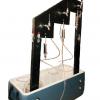I would personally be careful if you choose not to record it - god forbid you do have an incident with contaminated product from those 4 hours - at least if it's recorded with all the necessary corrective/preventative plans, times etc. you can go back and say yes we know the issue has arose from this situation... not oh now we have an incident actually yes there was an undocumented heater problem...
There is no harm in documenting things - if all is fine at least it shows you had good control of the situation.
Also if a contractor was on site surely he would have completed a maintenance form or something of a similar kind? Long shot and i look way too into things but a maintenance form to fix something that could impact the safety of the product without corresponding documentation to show the risk of the situation has been assessed? (apologies - i'm a bit of a jobsworth when it comes to cross referencing these things)
BUT having said that if anything like this arose at our site it wouldn't be documented, however that is purely because we are such a low risk product and i can't think of something at the moment that i can relate to in having an issue pose a food safety risk.
















